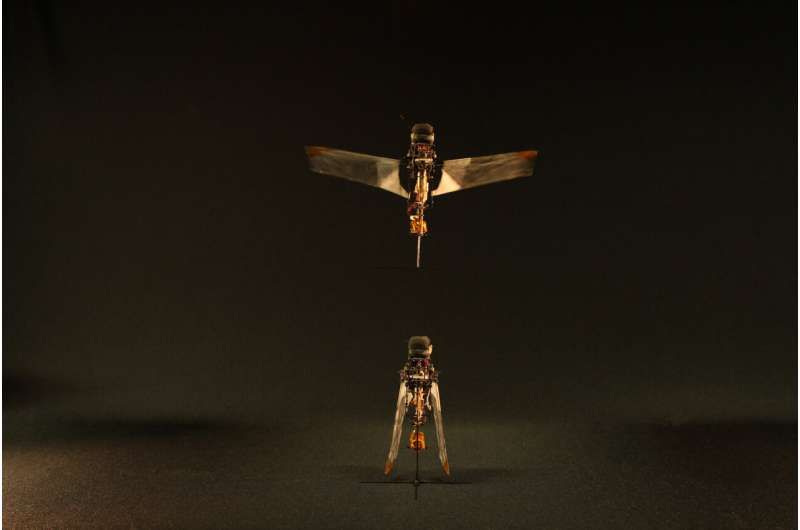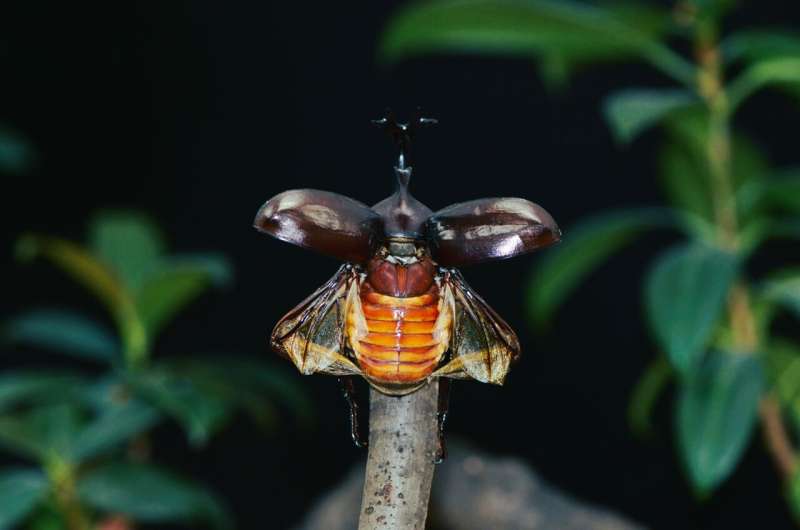August 4, 2024 feature
This article has been reviewed according to Science X's editorial process and policies. Editors have highlighted the following attributes while ensuring the content's credibility:
fact-checked
peer-reviewed publication
trusted source
proofread
A flapping microrobot inspired by the wing dynamics of rhinoceros beetles

The wing dynamics of flying animal species have been the inspiration for numerous flying robotic systems. While birds and bats typically flap their wings using the force produced by their pectoral and wing muscles, the processes underlying the wing movements of many insects remain poorly understood.
Researchers at Ecole Polytechnique Fédérale de Lausanne (EPFL, Switzerland) and Konkuk University (South Korea) recently set out to explore how herbivorous insects known as rhinoceros beetles deploy and retract their wings. The insight they gathered, outlined in a paper published in Nature, was then used to develop a new flapping microrobot that can passively deploy and retract its wings, without the need for extensive actuators.
"Insects, including beetles, are theoretically believed to use thoracic muscles to actively deploy and retract their wings at the wing bases, similarly to birds and bats," Hoang-Vu Phan, the lead author of the paper, told Tech Xplore. "However, methods of recording or monitoring muscular activity still cannot determine which muscles beetles use to deploy and retract their wings nor explain how they do so."
The hindwings (i.e., back wings) of beetles resemble foldable origami structures, as they can be neatly folded and stowed under the elytra (i.e., a hardened forewing typically found in beetles) while they are resting and then passively deployed when they fly. Many past studies aimed at replicating the dynamics of beetle wings in robots thus utilized origami-like structures, without paying much attention to movements at the base of the hindwings.
"This research is a follow-up of my previous work published in Science in 2020, where we discovered the shock-absorbing function of rhinoceros beetles' hindwings during in-flight collisions," Phan explained. "During the experiments, I accidentally captured a full two-phase wing deployment, and wondered why the beetle uses such a complex procedure if driven by active muscles."

In his previous examinations of rhinoceros beetles, Phan observed that these insects can leverage their elytra and flapping forces to passively deploy their hindwings for flight. Once their flight is over and they land on a surface, they then use the elytra to push the hindwings back onto their body. Both these actions are passive in nature, as they do not entail the use of thoracic muscles that support the flight of birds and bats.
"By implementing this passive mechanism into flapping-wing robots, we demonstrated for the first time that unlike existing flapping robots that keep their wings fixed in a fully extended configuration, our robot can fold the wings along the body when at rest and passively deploy its wings to take off and maintain stable flight," Phan said.
The researchers leveraged the insight they acquired from their study of rhinoceros beetles to build a flapping microrobot that weighs 18 grams. This microrobot, which is approximately two times larger than an actual beetle, can passively deploy and retract its wings.
"For simplicity, we used elastic tendons installed at the armpits that allow the robot to close its wings passively," Phan said. "By activating flapping motion, the robot can passively deploy its wings to take off and maintain stable flight. Thereafter, by stopping the flapping after landing, the wings can be rapidly and passively retracted back to the body without the need for any additional actuators."
The recent work by Phan and his colleagues unveiled that the mechanisms underlying how beetles deploy and retract their hindwings are passive and do not rely on muscle movements. It then introduced a viable strategy to reproduce these mechanisms in microrobots, thus increasing their similarity to insects.
"Our robot with foldable wings can be used for search and rescue missions in confined spaces," Phan said. "For example, it can enter a collapsed building where humans cannot access. With its tiny scale, the robot can fly into narrow spaces. When flight is not possible, the robot can land or perch on any surface, and then switch to other locomotion modes such as crawling."
Notably, when the team's microrobot is crawling, its wings rest along its body, which reduces the risk that they will be damaged while also enhancing the robot's mobility in narrow spaces. Once it finds a good spot to take flight, the robot can then simply deploy its wings again and switch back into flight mode.
"Our flapping robot could also help biologists to study the biomechanics of insect flight and could be disguised as spy insects to explore the life of real insects in forests, for which conventional rotary-wing drones are not applicable," Phan said. "In addition, the flapping robot could be used to carry out engineering research or as an engineering toy for kids, as its low-flapping frequency is very safe and human-friendly."
So far, Phan and his colleagues have assessed their microrobot's performance in a series of preliminary tests, which yielded promising results. In the future, their design could be further improved and tested in various real-world scenarios, to further validate its potential.
"In future studies, it would be interesting to explore whether other insects, such as tiny flies, use similar passive strategies in the context of limited muscle availability," Phan added. "We also aim to improve the agile flight of our robot, and to implement ground locomotion capabilities such as perching and crawling, similar to its biological counterparts."
More information: Hoang-Vu Phan et al, Passive wing deployment and retraction in beetles and flapping microrobots, Nature (2024). DOI: 10.1038/s41586-024-07755-9
© 2024 Science X Network
















